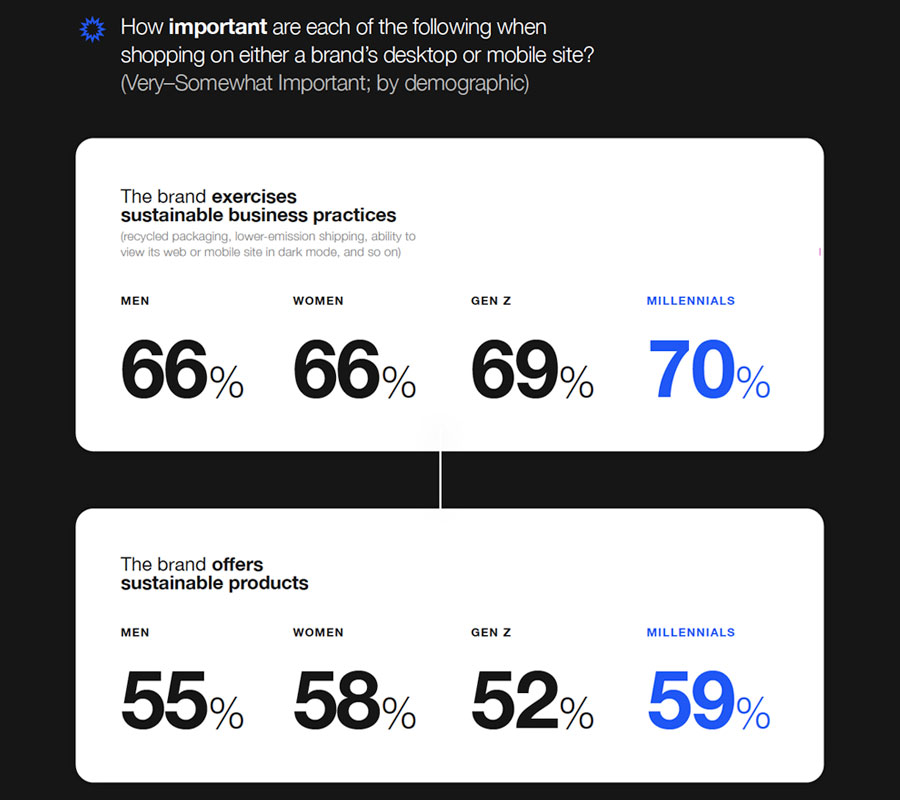Recent shifts in consumer behavior will significantly impact brand sales this year and beyond. Brand marketers need to refocus efforts on planet sustainability; otherwise, they risk losing their consumer bases to brands that do.
E-commerce specialist Astound Commerce, in partnership with digital commerce platform Shopify, just released the results of a study titled Sustainability and Your Customer. This new report follows a record year for an extreme climate in 2022 that ranged from a deadly Atlantic hurricane season to torrential rains and melting glaciers in Pakistan to Europe’s record-high temperatures not seen in nearly 500 years.
Global consumers have no illusions regarding the threat climate change poses in the long term, according to several recent studies. This latest report delves into recent shifts in consumer behavior and how that will impact brands in 2023.
The research revealed a strong willingness among consumers globally to pay more for a sustainable product. The report found that three out of five global consumers take note of a company’s stance on environmental issues. A favorable position on addressing climate change has had at least some impact on their decision to buy.
In light of this research, the bottom line for businesses is to consider the added cost of supporting the environment versus possibly not having a viable business, offered Vanessa Cartwright, CEO of the North America region for Astound Commerce.
“It is the younger cohort of customers that you know will be important for the future of your business. You know that you have to make some changes, or ultimately you will not be competitive with others,” Cartwright told The E-Commerce Times.
Results Reveal Shift in Shopping Priorities
Researchers deployed a survey to 1,000 global consumers from the Americas (Canada, Mexico, and the United States), Europe (Germany, Italy, the Netherlands, Switzerland, and the United Kingdom), and the Middle East (the Kingdom of Saudi Arabia and the United Arab Emirates).
The questions focused on obtaining an understanding of how consumer behaviors related to sustainability have evolved and how they will shape the future of commerce.
Gen Z consumers are the most influenced by a brand’s stance on environmental issues at 62%. These consumers use their purchasing power to advocate for climate action, indicating that brands need an authentic, transparent environmental messaging strategy.
According to the report, a solid margin of 70% of millennial consumers consider a brand’s business practices at least somewhat important when shopping online.
This sustainability report was Astound Commerce’s first, so there are no benchmarks from previous years yet. But the data spoke directly to the role products play in influencing what consumers purchase. What played a significant role, Cartwright observed, was consumer awareness of the brand’s supply chain practices.
For example, elements such as low emissions, shipping, and recycled packaging ranked high in deciding what brands to support by buying products. “A lot of the data was more of a supply chain side recognition about the role of packaging products efficiently is something getting to them,” she said.
Cartwright explained further that consumers are making decisions based on whether their purchases are packaged together in one single pass or come in individual discrete parcels. Also very important to them is the packaging used in that process.
“I think it speaks to a level of sophistication of understanding,” she observed.
Rallying Around Recommerce
The report emphasized the importance of reselling used products in dealing with environmental sustainability since reselling can help brands extend the lifecycle of their products, reduce waste, and solidify their commitment to sustainability.
The recommerce market has grown significantly in recent years — the report credits that growth to innovative startups and resale sites.
Statista projects the value of the secondhand apparel market to more than double in size in the next few years, reaching US$218 billion in 2026 and making it a powerful potential revenue driver for apparel brands, according to the report.
Recommerce can also give brands the added chance to resell returned products as a way to limit unwanted inventory that ends up in landfills worldwide. Consumers show strong interest in this solution, with 54% saying they are at least somewhat interested in this sustainable model, led by 59% of millennials.
Legitimizing Related Research
The Astound sustainability study dovetails on the findings of similar research done by the World Economic Forum (WEF) in the last two years. The WEF was established in 1971 as a not-for-profit foundation in Geneva by Klaus Schwab.
The 17th edition of the Global Risks Report released in January 2022 identifies tensions that will result from a divergent recovery to recent economic and environmental issues. Rapidly and slowly recovering countries will need to navigate economic and societal gaps to restore social cohesion, boost employment, and thrive.
According to the WEF report, the survey rated climate change inaction “as the risk with the potential to inflict the most damage at a global scale over the next decade.” Human health will bear the brunt of this damage in the form of disrupted food systems, diminished air and water quality, uninhabitable regions, and more as global temperatures continue to rise without action.
Consumers feel the magnitude of this crisis and want brands to act now, echoed Astound Commerce’s report that referred to the WEF study.
Beyond environmental efforts, brands should also consider their digital business practices as an immediate opportunity to drive their environmental goals forward, voiced Astound’s sustainability report.
It warned that managing heavy, outdated internal infrastructure, employing inefficient coding methods, and storing unused data can waste energy, contribute to your carbon footprint, and cost a brand valuable time and resources.
The Net Climate Cost of Commerce
Cartwright noted that the company’s research was very much about the consumers’ perspective and done at a global scale. It showed a major shift in consumers making purchasing decisions based on what they understand to be a company’s actions to make themselves more sustainable.
“How much of those decisions are really influenced by climate sustainability and what influences consumers the most I found interesting,” she offered.
The data revealed that while the product itself is important, consumers also highly value the climate cost associated with buying products.

Credit: Sustainability and Your Customer report by Astound Commerce and Shopify
Research shows a strong interest among consumers globally that products entirely recyclable or made from recycled materials had a larger percentage of people deciding to buy them influenced by sustainability.
Cartwright does not imagine that, typically, end consumers know a great deal about what happens in warehouses and the actual shipping processes. However, she does think that people have started to make decisions based on from where their purchases are shipped.
What kind of transportation is being used to get this product to me? If it is coming from a faraway place, and it is coming in a really short amount of time, it is likely coming by air rather than by sea, which seems probably least sustainable, she reasoned.
“So the fact that people are thinking as deeply as that and making those kinds of choices to me speaks that there is an evolution of understanding where it is not just, ‘Oh, this thing I’m buying happens to be recyclable or made from recycled product.’ It goes further than that,” she said.
How Organizations Can Advance Sustainability
Shopify, Astound Commerce’s partner in this report, educates consumers and gives them choices in helping to support sustainability. It uses its website as a marque for why planet sustainability is necessary.
In 2019, Shopify started sourcing renewable power for heating, cooling, and powering its buildings and employee home offices. According to its website’s sustainability page, the company procured enough green energy to account for its natural gas and electricity-related carbon footprint in Canada.
Cartwright offered another example of what the Goodwill Industries organization is doing to let consumers know what it is doing to foster sustainability. Goodwill sells used clothing and other items on its GoodwillFinds website.
The online store makes the group’s mission of distributing products to the needy much more readily available. The organization recovers more than three billion pounds of used goods annually, diverting them from landfills and giving them a second life.
GoodwillFinds openly displays how it provides a sense of sustainability on its website. Its “Your Choices Matter” motto states that buying a pair of “thrifted” jeans can conserve more than 1,800 gallons of water, keep toxins out of essential water supplies, and keep thousands of shredded fibers out of our oceans.


























































Social Media
See all Social Media